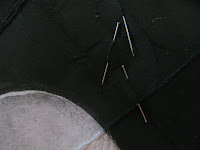The Foundling Museum was founded by Royal Charter in 1739. It was
founded by the determination and tireless petitioning of a man of principle,Thomas Coram. The destitute would have somewhere to deposit their babies and give them a future.
This process was however a lottery, the mother would come to the Hospital and have to take a ball out of a bag. The ball would be red, black or white. Red stood for 'maybe' , Black was for 'no' and white was 'yes'.
I am currently trying to replicate these balls in etching. The perfect sphere. Hard to achieve as I have discovered and you can see below. My next attempt will be using etching techniques from the time of the museum such as Mezzotint and Cross Hatching.
 | ||
| detail of engraving by Hogarth - woman | taking a ball out of the bag |
 |
| white ball means she can leave her baby |
On my last visit to the Foundling Museum in London, I became a member.http://www.foundlingmuseum.org.uk/ I have been attending talks given by John Styles who has written 'Threads of Feeling' - the Foundling Hospital's textile tokens, 1740 - 1770 http://lecturelist.org/content/view_lecture/9228
 It was during this particular research that I discovered the use of pins. The pieces of fabric left behind by the Mothers or sometimes cut away from the clothing the child was wearing at the time of admittance. These were preserved and pinned into a large ledger book. This got my attention and over time I started to assimilate my personal use of thorns associated with the death of my Mother with the use of pins in the Foundling ledger books.
It was during this particular research that I discovered the use of pins. The pieces of fabric left behind by the Mothers or sometimes cut away from the clothing the child was wearing at the time of admittance. These were preserved and pinned into a large ledger book. This got my attention and over time I started to assimilate my personal use of thorns associated with the death of my Mother with the use of pins in the Foundling ledger books. As a consequence I am experimenting with the pins being used within my printmaking process. Piercing the surface of the print and sometimes only leaving impressions.
 |
| Pins inserted into fabric identifier |
 |
| trial print with pins |

That last print with the pins is especially beautiful.
ReplyDeleteI wanna come to London and spend a few weeks going to galleries and museums with you.